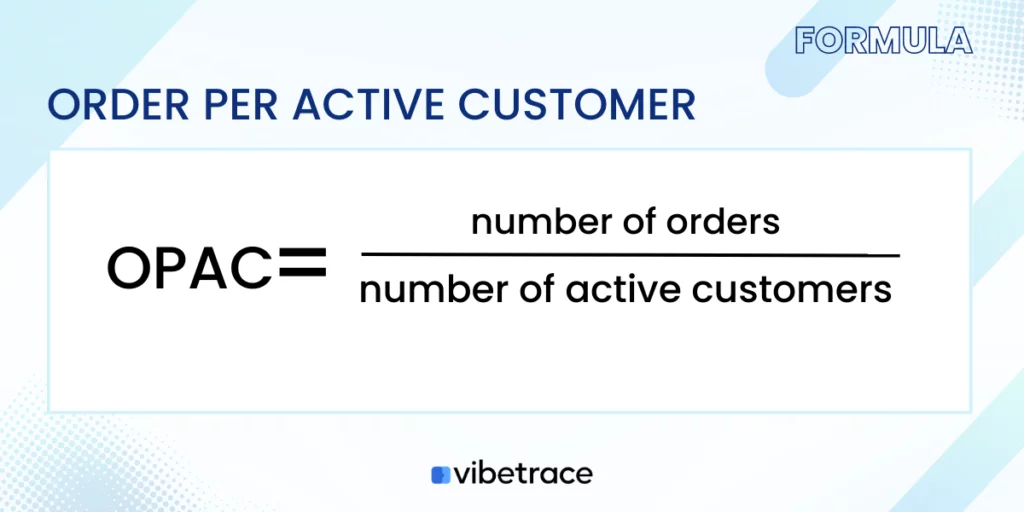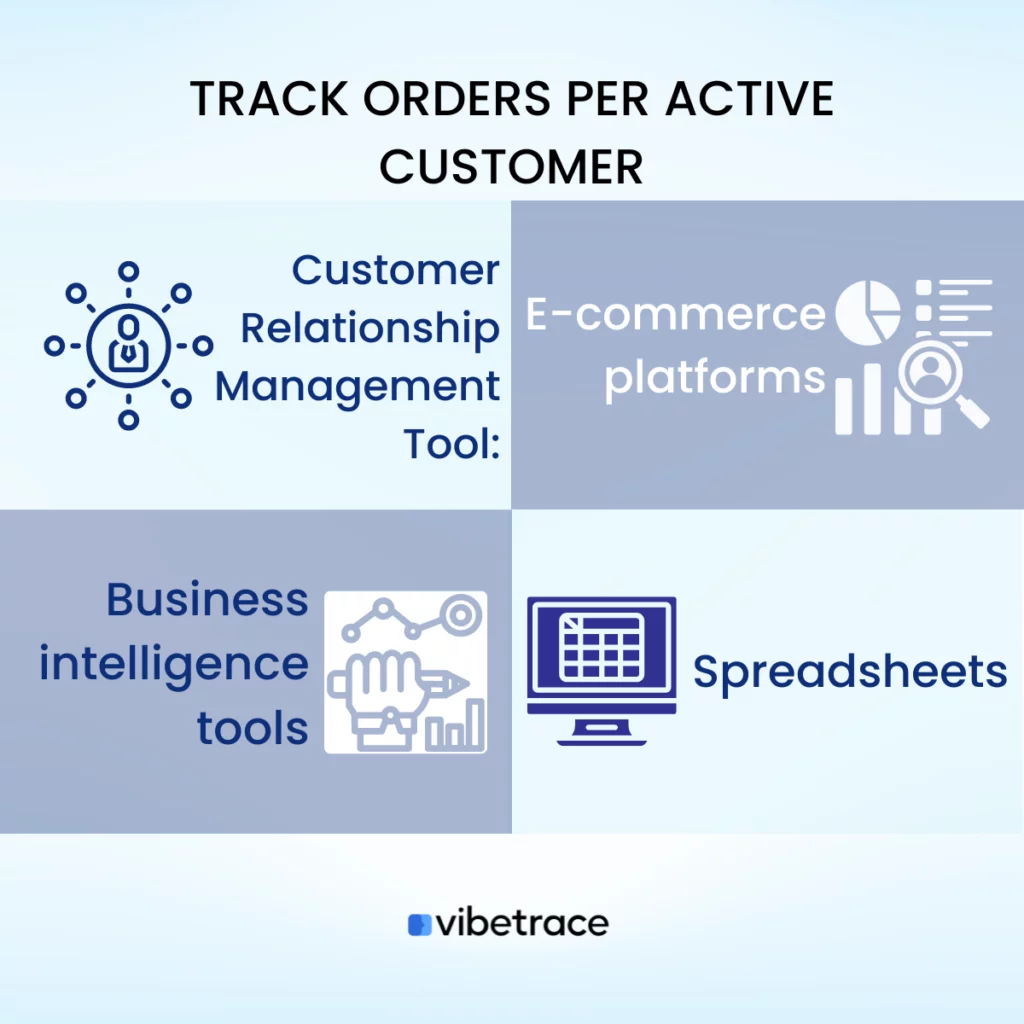Orders Per Active Customers is a metric frequently utilized by most businesses to gauge their appeal to customers’ preferences.
To enhance growth and revenue by drawing in more shoppers, it’s important to regularly monitor your orders per active customer.
This metric offers valuable information about customer retention and satisfaction levels throughout their lifecycle with your business.
You also want to have a high customer retention rate, right?
What is Orders Per Active Customers?
Definition of Orders Per Active Customers
Orders Per Active Customers is a metric used to measure the average number of orders placed by a single active customer within a specific period of time.
Orders Per Active Customer is a useful metric for businesses to track because it can help them understand customer behavior and loyalty. It can also be used to identify trends or changes in customer purchasing habits over time.
Through monitoring this metric, you can make data-driven decisions about marketing, pricing, and other strategies to increase your customer engagement and drive revenue growth.
Orders Per Active Customers Formula

It is calculated by dividing the total number of orders placed by active customers during a given period by the total number of active customers during that same period.
For example, if your company had 1,000 active customers during a month and those customers placed a total of 2,000 orders, then the Orders Per Active Customer for that month would be 2 (2,000 orders divided by 1,000 active customers).
Orders Per Active Customer Benchmarks by Industry
Orders per Active Customer (OPAC) benchmarks vary by industry and can depend on factors such as the type of product or service being sold, the target audience, and the business model. Here are some OPAC benchmarks by industry:
E-commerce: The average OPAC for e-commerce companies is around 2-3 orders per active customer per year. However, this can vary widely depending on the type of products being sold.
Subscription-based businesses: For businesses that offer recurring subscriptions, the OPAC is usually higher. The benchmark for subscription-based businesses is around 12 orders per active customer per year.
Retail: Retail businesses typically have a lower OPAC compared to e-commerce and subscription-based businesses. The benchmark for retail businesses is around 1-2 orders per active customer per year.
Food and Beverage: The OPAC for food and beverage businesses can vary depending on the type of establishment. For example, the benchmark for quick-service restaurants is around 5-6 orders per active customer per month, while for fine dining restaurants it may be lower.
Travel and Hospitality: The OPAC for travel and hospitality businesses is also dependent on the type of business. Hotels, for example, may have an OPAC of around 1-2 orders per active customer per year, while online travel agencies may have a higher OPAC due to the nature of their business model.
How to track Orders Per Active Customer?
There are a variety of tools that can help you track Orders Per Active Customer. Here are some examples:

Customer Relationship Management (CRM) software: CRM software like Salesforce, HubSpot, or Zoho can assist you in tracking customer activity and purchases over time. You may generate the Orders Per Active Customer metric and analyze trends over time by tracking orders and active customers in a CRM.
E-commerce platforms: If you own an e-commerce store, your e-commerce platform may include reporting features that allow you to track Orders Per Active Customer. Shopify and WooCommerce, for example, both have reporting and analytics tools that can help you monitor customer behavior and calculate Orders Per Active Customer.
Business intelligence tools: Tableau, Looker, and Power BI are business intelligence tools that may help you track Orders Per Active Customer by extracting data from numerous sources and building bespoke visualizations and dashboards.
Spreadsheets: Tableau, Looker, and Power BI are business intelligence tools that may help you track Orders Per Active Customer by extracting data from numerous sources and building customized visualizations and dashboards.
The best tool for tracking Orders Per Active Customer will be determined by your company’s specific demands, the size of your client base, and the complexity of your data. You can acquire insights into your customers’ behavior and uncover chances for growth and improvement by selecting the right tools for your organization.
How often should you check Orders Per Active Customer?
The frequency with which you should check Orders Per Active Customer depends on the size and complexity of your business, as well as your goals and objectives. Here are a few general guidelines to consider:
Monthly: At a minimum, you should review your Orders Per Active Customer metric on a monthly basis. This will allow you to track changes over time and identify any trends or anomalies that require further investigation.
Do you like this article?
Join our CX for Retail dedicated newsletter!

Stay connected to what’s really important to optimize your digital revenues.
By clicking the button, you accept our Terms & Conditions. Also you will need to confirm your email address.
Seasonal: Depending on the nature of your business, you may need to check Orders Per Active Customer more frequently during certain times of the year. For example, if you run a retail business, you may want to check this metric more frequently during the holiday shopping season.
During and After Campaigns: If you are running marketing campaigns to drive customer engagement and sales, you should monitor your Orders Per Active Customer metric during and after the campaign to determine its effectiveness.
Orders Per Active Customers Calculator
Do you want to calculate your order per active customer? Use our simple calculator below.
Simple Orders per Active Customers Calculator
Number of orders:
Number of Active Customers:
Orders per active customer
= ?
Important Things about Orders Per Active Customers
Here are some important things to keep in mind about Orders Per Active Customers:
A metric for customer retention: A high number of orders per active customers indicates that customers are engaged with your business and are more likely to become loyal customers. Loyal customers tend to make repeat purchases and can be more profitable over time than acquiring new customers.
Identify trends: Changes in orders per active customer over time can indicate trends in customer behavior, such as changes in product preferences or changes in marketing campaigns.
Compared to industry benchmarks: You can use industry benchmarks to compare your orders per active customer to competitors and identify areas for improvement.
Used to set targets and goals: By setting targets for orders per active customer, you can work to increase customer engagement and loyalty.
Affected by the frequency of purchase: If your business is with products or services that are purchased more frequently then it is likely to have higher orders per active customer than businesses with products or services that are purchased less frequently.
Tracked alongside other metrics: Simply increasing the number of orders per active customer is not always beneficial. You should also consider the quality of the orders, such as the average order value and the customer’s lifetime value, to ensure that they are maximizing profits.
Metrics related to Orders Per Active Customer
There are several metrics related to Orders Per Active Customer that can provide additional insights into your business’s performance. Here are a few examples:
Customer Lifetime Value
The estimated total value of a customer to a business over the course of their lifetime
Average Order Value
Churn Rate
The percentage of customers who stop using a product or service over a given time period.
Customer Acquisition Cost
The cost of acquiring a new customer, including marketing and sales expenses.
Time Between Purchases
The average amount of time that elapses between a customer’s orders.
Vibetrace is here to help your business increase its Orders per Active Customer (OPAC) through the use of its different features such as personalizing messages, upselling and cross-selling by suggesting products, and providing detailed analytics reports.
Vibetrace can help your business improve OPAC by creating personalized experiences for customers, re-engaging inactive customers, and providing insights and analytics to inform data-driven decision-making.

